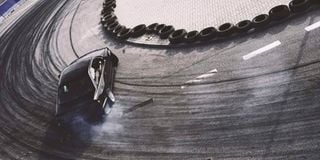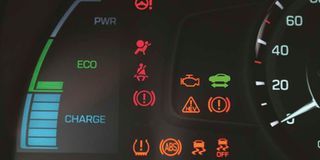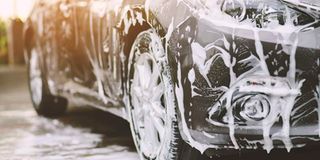Premium
What is driving you round the bend?

A flying drone of a professional driver drifting car on asphalt track.
Gavin, what’s the difference between oversteer and understeer and what causes each? Also, just how dangerous are these two situations?
If you drive a car round in a circle where the road surface and speed allow perfect traction, the back wheels will follow the same line as the front wheels. That is “neutral steer”.
If the surface is loose or slippery, and/or speed is progressively increased, traction to resist the centrifugal force of the turn will be compromised and the tyres will start to slip sideways towards the outside of the turn.
If both front and rear tyres slip at the same time and by the same amount they will still, follow each other (still neutral steer) but the circle they scribe will get bigger and bigger.
However, if at any point the rear wheels slip first or by more, the rear of the car will slide wider and the front of the car will “tuck in”. That is oversteer. The body of the car turns too much.
If that process is continued with greater speed and no correction, the car will eventually “spin”.
If the front wheels slip first or by more, the car will not follow the circle but tend to drive out of it at a tangent. That is understeer. The body of the car does not turn enough.
Applying these principles to cornering at speed on a real road, oversteer will cause a drifting slide or a spin and a potential roll; understeer will quickly take you to the side of the road (and perhaps over the edge or into the bush). There are a number of forces at play here.
One is the momentum of the vehicle. A two tonne car travelling at 100 km/ph. generates 55,000 kilos per meter per second of that – more than enough to punch a hole in a concrete wall. Much of that momentum becomes centrifugal force when the vehicle changes direction (starts a circular turn).
For the car to maintain the integrity of steering direction, the tyres must grip well enough to counteract those forces. As the tyres fight that battle, there is a dynamic shift in the weight of the vehicle (towards the front when braking, and towards one side when cornering). As the force becomes more extreme, something has to give. Either the tyres will lose grip and the car will slide or spin or, the if they don’t slip, dynamic weight transfer can become so great that the car rolls.
Momentum and centrifugal force are not just theoretical concepts. They are just as real as, and often a lot stronger than, gravity.
Don’t forget to “shuffle” your tyres

A flat tyre.
I got a flat tyre and went to have it changed at a nearby petrol station. The tyre was repaired well. When I was leaving, however, the attendant pointed out that the front tyres were worn out and advised me to swap them with the ones at the back, which were in better condition. What advantage is there to have less worn out front tyres? And why do front tyres wear out faster than rear ones?
Front tyres do usually wear out faster simply because they do a lot more work (especially on front-wheel drive cars which are now the overwhelming majority).
They not only go round and round and up and down (like the rear wheels) but also suffer additional “scrubbing” action as they bear the brunt of braking forces (70%) and the higher cornering loads as they fight forward momentum whenever you turn the steering wheel. Rear wheels mostly follow the direction of travel while the front wheels are frequently working (and scrubbing) to change it.
The drive wheels (be they front or rear) also transmit the engine power for acceleration. On rear wheel-drive cars, the back wheels do that but are less likely to scrub as they do so because acceleration throws the dynamic weight of the vehicle to the rear; the extra weight means extra traction and less scrub.
When front-wheel drive cars accelerate the weight is still thrown backwards and the load at the front is reduced – less weight means less traction and hence more scrub.
Because wear can be uneven in these ways and for other reasons like poor alignment/toe-in/castor angles etc. good service practice rotates the wheels at major service intervals (e.g. front right to back left, and back right to front left). You can also incorporate the spare wheel in that shuffle process.
Whichever swap-round method you use, the principle should always be to put the tyres in best condition (those least likely to suffer failure) on the front, for safety reasons. If a rear tyre fails suddenly, the car will suffer less loss of line and usually be easier to bring to a safe halt. If a front tyre fails, loss of line can be faster and more severe all the controls (especially steering) you need to cope with that are more severely compromised.
When judging which tyres are in best condition, it is not just the depth of the tread that counts. Also check the condition of the tyre walls and remember, if you can, which ones have had a “big” puncture. The right repair can often make them serviceable, but never “as good as new”.
***
Why does my car’s “check engine” light keep coming on? I have also realised that one signal light is blinking faster…

Car dashboard warning lights.
The bulbs in indicator lights tend to fail more frequently than other car lights (perhaps because of the extra stress caused by the on-off-on-off operation), but failure is not always easy for the driver to spot.
Indeed, the story goes that a driver asked a bystander to check whether his rear indicators were working, and the call he got from behind the car was “yes they are; no they’re not, yes they are…)
So most modern cars have arranged a warning system - if one indicator bulb fails, both the dashboard “green arrows” and the other indicator lights blink faster. The faulty bulb needs to be identified and replaced.
“Engine” warning lights on the dashboard are notoriously vague. They are supposed to come on when you turn on the ignition switch (so you know they are working), but go off as soon as the engine is started (and stay off unless and until an engine fault occurs).
If they come on again when the vehicle is running, they are a message that “something” is wrong with the engine. There probably is a fault, somewhere, but it might be the warning light itself that is faulty, such as a defect in just one of the ECU sensors that measures one of the items the warning system monitors. If the engine light comes on for no apparent reason, first and immediately double check against the oil and temperature warning lights. If they are okay and there are no sounds or smells or mechanical behaviour indicating a problem, then a faulty “engine” light is a prime suspect.
Cars with sophisticated computerised engine management can do a lot more than turn a warning light on. They can limit revs and speeds (to maximise your chances of reaching a garage) and send you a digital diagnosis message about what needs to be fixed and how urgently. Some even know where you are, where the nearest agent (or listed independent garage) for your car is, and can forewarn them to get the right spare part ready!
The difference between a squeak and a screech

Outdoor car wash with foam soap.
Whenever I take my car to the car wash, the brakes squeak loudly when I reverse. What could be the problem and how do I resolve it?
High pressure car washers can do a wonderful job of cleaning your car – especially in hard-to-reach places (which are thus often the most neglected). But, in clumsy hands, they can also inject water into places not best suited to getting wet.
Almost anything which changes your car’s behaviour or sound immediately after a wash can be attributed to that downside.
Brakes do squeak – either intermittently or constantly – for a number of different reasons. There could be a twig or stone trapped in the works, or metal in the friction material of the pads (for disc brakes) or shoes (for drum brakes), or dust or rust or dirt or water between the pads and discs, and so on.
These can often, but not always, be cleared by hard-braking a few times (good idea to check the rear view mirror before trying that solution). If the friction material is completely worn away, the noise is more likely to be a screech and a lurid grating noise than and squeak.
Your brakes should never reach that state of wear if the vehicle is properly serviced. Even if there is plenty of wear left in the friction materials, the whole system should be checked, cleaned, and if necessary the friction material should be lightly sand-papered to get rid of any “glazing” which can be caused if the brakes get too hot (either through very severe use or by “riding” your foot on the brake pedal when going down long and steep hills. Change down a gear and use engine braking to avoid that).
Your note suggests that the squeak when reversing happens only immediately after a carwash, and then stops. The cause is probably a little water which quickly evaporates when the brakes are used. Nothing to worry about.
If lots of water gets into the braking mechanism (such as when you drive through flood water on the road or across a river) it can completely negate the friction between the pad and the disc. The brakes will hardly work at all until they are dry (and until they work, they won’t generate the heat that will help them dry).
You should always be aware of this when you cross deep water (in some countries such crossings are often followed by a reminder sign which says “Test Brakes”). Drying can be speeded up while you are still in a low gear at relatively low speed but with plenty of engine revs by simultaneously pressing lightly on the brake pedal as you continue to drive forward. That will rub the water away and start to generate enough heat to evaporate the rest.
Next week: Cleaning piston rings, dismantling engines, the pros and cons of diesel and petrol engines, drive configurations, and more.





